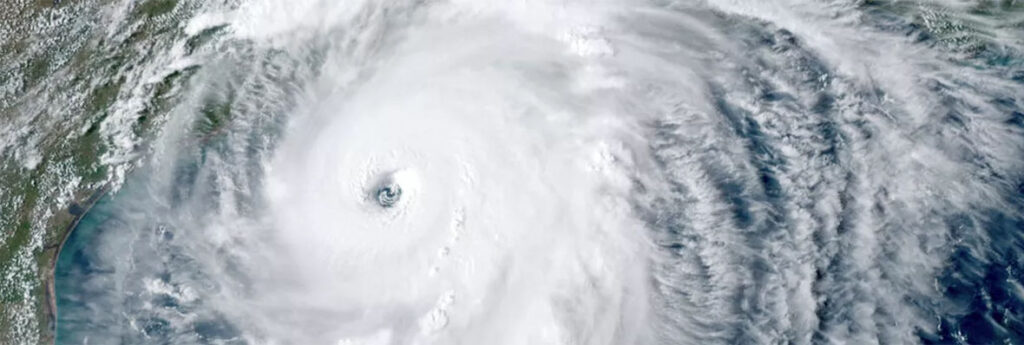Forecasters say Hurricane Laura has made landfall in southwestern Louisiana as an “extremely dangerous” Category 4 hurricane. Forecasters warned the strong winds could rip apart buildings, level trees and toss vehicles like toys.
The National Hurricane Center reports the storm made landfall at 1 a.m. CDT on Thursday near Cameron, a 400-person community about 30 miles (48 kilometres) east of the Texas border. It had maximum sustained winds of 150mph (240 kph), making it the most powerful hurricane to strike the US so far this year.
Hurricane-force winds and damaging wind gusts are spreading well inland into parts of eastern Texas and western Louisiana.
The hurricane centre has updated its guidance on the ocean water pushed ashore, saying they expect unsurvivable storm surge with large and destructive waves will cause catastrophic damage from Sea Rim State Park, Texas, to Intracoastal City, Louisiana, including Calcasieu and Sabine Lakes.
Forecasters predict the highest surge, up to 20 feet, along a stretch of Louisiana coastline that includes Johnson Bayou and the towns of Holly Beach and Cameron.
Forecasters say this surge could penetrate up to 40 miles inland from the immediate coastline, and flood waters won’t fully recede for days.
Lake Charles
Videos on social media show heavy winds and rain battering a tall building in Lake Charles, Louisiana, blowing out windows and littering glass and debris into the air and onto the ground as Hurricane Laura moves over southwestern Louisiana.
The damage was observed in Lake Charles, which is about 45 miles (72 kilometres) north of where the storm made landfall in Cameron early Thursday.
Other videos from the area show road signs bending, trees shaking violently and a large recreational vehicle being blown over.
More than 290,000 homes and businesses were without power in Texas and Louisiana, as near-constant lightning provided the only light for some. Officials say search and rescue missions will begin as soon as conditions allow, along with damage assessments.
People were warned to evacuate
At least 150 people refused to evacuate a coastal Louisiana parish that could be covered by ocean water as Hurricane Laura makes landfall, officials said.
Officers went door-to-door in Cameron Parish urging the roughly 7,000 residents to get out before Laura struck, and they all used social media and phone calls to warn people of the danger.
But Ashley Buller, assistant director of the parish Office of Emergency Preparedness, said officials knew of about 150 people who decided to stay put in structures ranging from seemingly safe elevated homes to recreational vehicles, which could easily be swept away by rushing storm surge.
“It’s a very sad situation,” Buller said in a telephone interview from Lake Charles, where parish officials relocated from an office closer to the coast in Cameron. “We did everything we could to encourage them to leave.”
An official in a southwestern Louisiana parish says some people who did not evacuate are now requesting assistance.
Tony Guillory, president of Calcasieu Parish’s police jury, was hunkering down in a Lake Charles government building that was shaking from the storm early Thursday as phones were ringing.
“People are calling the building but there ain’t no way to get to them,” he said over the phone.
Guillory said he hopes those stranded can be rescued later Thursday, but blocked roads, downed power lines and flooding could complicate the process.
Highway closing
Louisiana Gov. John Bel Edwards said the state is closing Interstate 10 from around the Atchafalaya Bridge outside of Lafayette all the way into part of Texas because several stretches within that area are expected to flood.
Apocalyptic language
In a radio interview Wednesday night, Edwards talked of the “apocalyptic” language that meteorologists have used for the storm. “The language I’ve heard from the National Weather Service I’ve never heard before … They’re sending the strongest possible message about how serious this storm is,” he said.
He talked specifically about concerns in Cameron Parish, which could receive wind gusts up to 180 mph (290 kph) and storm surge up to 20 feet (6 metres.)
“When people built back after Rita, they routinely built back to 15 feet,” Edwards said. He noted those structures would be overwhelmed.
Edwards said search and rescue efforts will begin Thursday as soon as it’s safe enough for officials to go out into floodwaters.
Forecasters said Gulf waters could rise 20 feet along the coast of the low-lying parish without adding the height of waves, meaning the entire parish could be inundated.
Louisiana Gov. John Bel Edwards said: “They’re thinking Cameron Parish is going to look like an extension of the Gulf of Mexico for a couple of days.”
Oil platforms evacuated
Nearly half of the oil and gas platforms in the Gulf of Mexico – almost 300 – were evacuated by Wednesday, along with most of the offshore rigs. Producers shut in 84% of the oil produced in the region, taking about 1.6 million barrels per day off the market. The Gulf region usually produces about 15% of the oil in the US. Producers also shut in about 61% of the natural gas produced in the Gulf.
“Risk level is high,” said Stewart Glickman, energy equity analyst at CFRA, in an email. “Platforms out in the Gulf can be damaged, the refineries (mostly in low-lying land) can be flooded, especially if a storm lingers around for days like Hurricane Harvey did in 2017.”
While some oil production is temporarily suspended, experts say it’s unlikely to cause problems for supply in the US. There has been a surplus of oil production this year, and demand for fuel is still well below pre-pandemic levels. Producers outside the region can pick up the slack.

